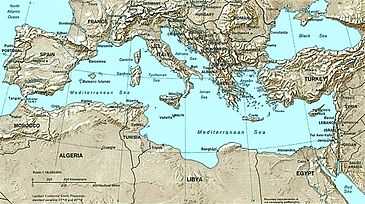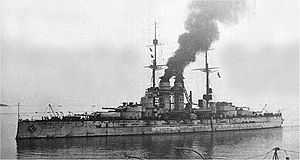Naval warfare in the Mediterranean during World War I
| Naval warfare in the Mediterranean (1914-1918) | |||||||
|---|---|---|---|---|---|---|---|
| Part of Naval warfare of World War I | |||||||
 The Mediterranean Sea and surrounding regions | |||||||
| |||||||
| Belligerents | |||||||
|
|
| ||||||
| ||||||
There was sporadic naval warfare in the Mediterranean during World War I between the Central Powers' navies of Austria-Hungary, Germany and the Ottoman Empire and the Allied navies of Italy, France, Greece, Japan, America and the British Empire.
Austro-Hungarian Imperial and Royal Navy
Austria-Hungary was a medium-sized naval power in 1914. It had a coastline from Trieste (in present day Italy) to below Cattaro in Montenegro. The Austro-Hungarian Navy had a number of pre-dreadnaught and numerous new battleships, including four powerful dreadnaught Tegetthoff-class battleships and a number of submarines. In addition, the Germans managed to send some U-boats to the Mediterranean which operated from Austrian naval bases, initially under the Austrian navy flag, later under the German navy flag.
Italian Regia Marina (Royal Navy)
The Kingdom of Italy during World War I had six dreadnought battleships (Dante Alighieri as a prototype, Giulio Cesare, Conte di Cavour and Leonardo da Vinci of the Conte di Cavour class, Andrea Doria and Caio Duilio of the Andrea Doria class).

During the war, the Italian Royal Navy kept her most modern capital ships out of the Adriatic Sea, leaving a few pre-dreadnaughts to do any fighting with the Austro-Hungarian Navy.[1] The so-called Adriatic Campaign of World War I consisted mainly of Austro-Hungarian coastal bombardments of Italy's Adriatic coast harbours, notably Ancona and Bari, wider-ranging German and Austro-Hungarian submarine warfare into the Adriatic and the Mediterranean, and Italian use of new weapons (mainly MAS and human torpedoes) that were successful in the sinking of two Austrian battleships in the last months of the war.
For most of the war the Italian and Austro-Hungarian navies each kept a relatively passive watch over their counterparts. The Italian fleet lost the pre-dreadnought battleship Benedetto Brin at Brindisi (27 September 1915); and on August 2, 1916, the Italian dreadnought Leonardo da Vinci exploded at Taranto, killing 249 of its crew. Reminiscent of the USS Maine, the event was widely reported in the Italian press, which immediately blamed Austrian or German saboteurs. The cause of the explosion was most likely unstable lignite as munitions were being loaded at the time of the explosion.
Italian sinkings of Austrian battleships
In December 1917, Luigi Rizzo with his MAS motor-torpedo boat sank the Austro-Hungarian pre-dreadnought battleship SMS Wien, which was at anchor inside Trieste harbour.[2]

In the early hours of June 10, 1918, Admiral Horthy and a number of ships were heading for the Otranto Barrage to make a surprise attack. As the fairly new dreadnaught the SMS Szent István was steaming past the island of Premuda off the coast of Dalmatia, a small Italian motor boat carrying two torpedoes, again commanded by Luigi Rizzo - the second coincidence of the night - on its way back to Italy, suddenly saw the battleship approaching. Both torpedoes were fired and hit the battleship. Despite valiant efforts by the crew with the pumps, and attempts to tow it to a port, after several hours water levels could not be contained and the ship capsized.
The second was described at the time as possibly the most cowardly act of the Italians during the conflict, using a small human torpedo called "Mignatta", which carried two men. A condition of the Allied-Austro-Hungarian Armistice was to surrender the entire Austrian fleet to the new National Council of Slovenes, Croats and Serbs. Rossetti, the officer on the 'human torpedo' claimed he did not know of this decision.[3] On November 1st, 1918, managing to bypass the submarine nets and boom at the harbour entrance by following a ship in, the Italians placed two magnetic mines below the water-line on the hull of the anchored battleship SMS Viribus Unitis causing a massive explosion in the early hours. The vessel soon filled with water and capsized trapping a great many of the sleeping sailors. The Slav National Council made no efforts to raise the ship, as Italy occupied the region only a few days later.
Campaigns
In the Mediterranean Sea, the war began with most of the large, but elderly French fleet deployed on escort duty to protect convoys across the Mediterranean from the smaller, but newer Austrian fleet and cover against possible Italian entry into the war on Austria's side. Several British ships were also sent to Malta to reinforce the British Mediterranean Fleet. Germany also had a small presence in the Mediterranean with a few ships based at the Austrian naval base of Pola (in current day Croatia) and at the commencement of hostilities, their powerful cruiser SMS Goeben and the light cruiser SMS Breslau, were patrolling the western Mediterranean. The German ships had not found the French convoys, so proceeded to bombard the cities of Bizerte and Bône in the French protectorate of Tunisia. Pursued by larger French and British forces, the Goeben and Breslau ran for Turkey, where they were nominally transferred to the Ottoman Navy when the Ottoman Empire entered the war on the Central Powers side, and fought several battles against the Russian Black Sea Fleet until Russia's surrender in 1917.
After the Kingdom of Italy entered the war on the Allied side in 1915, the strategy of the Allies was to blockade the Adriatic at the Otranto Straits and monitor the movements of the Austrian fleet. In general, this strategy was successful, but the Austrians attacked the barrage on several occasions sinking many vessels: on the night of the 26/27 April 1915 the Austrian submarine U-5, commanded by Lieutenant Georg Johannes von Trapp (of Sound of Music fame), sank the French cruiser Léon Gambetta.
The Austrians and Germans were also able to send submarines out into the Mediterranean where they did some damage. Total Allied warship losses to Austrian and German submarines were: two battleships, two armored cruisers, five destroyers, and two submarines (in addition to many damaged navy ships and sunk freighters). The primary sea bases for the Austrian fleet in the Adriatic were Pola (in Istria) and Cattaro (in southern Dalmatia).
The Allied navies were able to sail relatively freely throughout the Mediterranean by keeping the Central Powers' surface units bottled up in either the Adriatic or at Constantinople. This freedom of movement was tremendously important for the Allies, as they were not only able to keep open their supply routes (to Egypt for example), but to also evacuate the remains of the Serbian Army from capture and even launch (and supply) amphibious invasions at Gallipoli in 1915 and Salonika in 1916.
In 1915, the major fleet action was the failed Allied attempt to knock the Ottoman Empire out of the war by an attack on Constantinople. The Allies needed to pass the Dardanelles strait in order to supply Russia. The Battle of Gallipoli lasted for most of the year but was unsuccessful. An initial naval assault was defeated by mines and coastal fortresses, and the subsequent land assault was also defeated, but with heavy casualties on both sides.
After Gallipoli, the only significant naval battle occurred on May 15, 1917 when three Austrian cruisers under Captain Miklós Horthy staged a raid on the Otranto Barrage, an Allied naval blockade of the Strait of Otranto. The raid was a partial success but the raiders were nearly destroyed by a shell hit which knocked out an engine on the Austrian cruiser SMS Novara. With heavier Allied forces closing in, the Austrians returned to Pola. The Austrians then decided to raid patrol boats guarding the Otranto Straits between Italy, Corfu and Albania. For further details see the battle of the Otranto Barrage.
Secondary campaigns and interventions
Allied fleets also played a role in coercing the Greek government to join the Allies and later supply the campaigns in Palestine and Macedonia. Although Germany was able to gain control of the Black Sea and part of the Russian fleet after the collapse of the Russian Empire, they were never able to break out into the Aegean. The German–Turkish fleet tried in 1918, but hit a minefield; the Breslau was sunk and the Goeben almost followed that fate, but the captain was able to run the ship aground and beach it before capsizing. The Goeben was not repaired until after the war.
Allied fleets occupied Constantinople briefly after the Armistice of Mudros, until the new Turkish Republic under Mustafa Kemal took back control of the city in 1923.
Allied ships did continue to intervene in Russia after the war ended, bringing expeditionary forces and supplies via the Mediterranean to the White armies in southern Russia.
Japan, an ally of Great Britain, sent a total of 14 destroyers to the Mediterranean starting in April 1917. The Japanese ships were very effective in patrol and anti-submarine activity (The Japanese Navy spent 72 percent of their time at sea compared with 60 percent by the British and about 45 percent by the French and Italian Navy).[4][5][6] However, the Austro-Hungarian navy lost nine submarines during the war: five sunk by the Italian navy (U-10, U-12, U-16, U-20, U-23), one by Italian and French units (U-30), one by British units (U-3), none by the Japanese navy,[7] which converserly suffered 68 dead and heavy damage on the destroyer Sakaki, torpedoed by Austrian submarine U-27.[8]
Notes
- ↑ Italian Navy in WWI
- ↑ NY Times article on Luigi Rizzo sinking of the Wien and other attacks
- ↑ Assault on the Viribus Unitis
- ↑ Falls, p. 295
- ↑ Timothy D. Saxon/Anglo-Japanese Naval Cooperation, 1914-1918
- ↑ Rising Sun in the Mediterranean-Second Special Squadron,1916-1918
- ↑ Austro-Hungarian Navy
- ↑ Imperial Japanese Navy
Sources
- Falls, Cyril (1961). The Great War. Capricorn Books.
- Halpern, Paul G. (1995). A Naval History of World War I. Routledge. ISBN 1-85728-498-4.
- Austrian Navy WWI downloaded from Naval-History.net (May, 2006)
- Mediterranean Campaign downloaded from Naval-History.net (May, 2006)
External links
- World's Navies in World War 1, Campaigns, Battles, Warship losses
- Detailed War in the Mediterranean sea